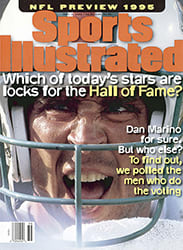
TO CATCH AND KILL THE AUTHOR EXPLAINS HER LOATHING FOR CATCH-AND-RELEASE FISHING
It is dusk on the Bitterroot, late summer, one star awake. I'm
standing on a rotten log that is as wide, dark and slick as a
hippo. I've been fishing for hours and have two long rainbows
curved together in my creel, sleeping the big sleep. An
unencumbered cast away is a glimmery hole that has come to life.
Excited strikes ping the surface, like sniper fire on a
plate-glass window. The air has gone suddenly cool. I feel as if
the fish are watching me teeter in my tennis shoes as I try to
thread my last Royal Wulff.
My bare legs feel rubbery from hours in the cold water, and my
head is light from the sun and no dinner. Vertigo induced by
focusing up close--with rushing water as a backdrop--makes me sway
a little. At my feet the liquid swirl funnels with sudden force
into the slope of my log. It joins a jumble of hidden waters
caterwauling under a riprap of auto carcasses and a busted
beaver dam. Any fish I caught would head right for this trap,
snap the line, topple me over. I am dimly aware that if I were
to fall, I would be sucked in, rod, creel and all, and my
husband, John, waiting at the appointed hour, could only--after
a long night's search--guess what had happened, and they would
never find my body.
Finally I get the fly on, squint at the pockmarked plate and
start casting.
This is about catch-and-release fishing. I find it fearful and
repellent. Catch and kill, that's what I do.
I learned to fish on the Blackfoot River in Montana in the
summer of 1980. I was working mornings and John was waiting to
enter law school, and we fished every day. I didn't like the
thwack on the skull and the quivering transition between tense,
wet life and dead meat. Every death sat cold on my soul for a
few moments before I shook it off and rejoined the quest for
more fish. But there weren't that many deaths.
I never took fishing past the rudiments. I used two kinds of
flies: Royal Wulff and Joe's Hopper. Easy to cast and easy to
see. I always wore shorts and tennis shoes; if those wouldn't
work, then it wasn't fishing weather. I didn't like to carry a
net, so I tried to catch fish where I could land them. Sometimes
I would carry my fish skewered on a stick, like scalps or prizes.
This minimalist approach appealed to me. I felt pulled together
and close to the ground as we set off through the brush, my rod
held horizontal, pointing the way.
When we would regroup, John would show me his one fish and I'd
show him my two, feeling pleased with myself. Only later did I
realize he was letting a lot go.
We always set out, though, with the intent of bringing something
home. While I got many strikes for every fish I caught, in my
mind they were all connected parts of a set piece, preludes to
the Big One. I would flail away, tired and cranky, unable to
stop. Then a rush of almost liquid pleasure would fill my arms
and legs as I finally brought in a flashing fish, wondrously
vanquished, its approach a huge concession.
I never equated the nibbles and sharp splashes with simple
protein intake; the fish, I felt, were egging me on--they could
see me, I couldn't see them. I felt momentarily exposed,
vulnerable yet full of desire. Each strike was a heartstopping
moment in a serious courtship.
In my favorite photo of John fishing, he is bare-chested and
snake-skinny, and he has a delightful Mephisto-like leer, unlike
those decked-out, be wadered fishermen we would run into. They
seemed so careful and plodding in their big rubber boots.
And there I am, hunting and gathering in my cutoffs and T-shirt.
I look androgynous. There weren't many women fly-fishing then,
or so I liked to think. I could fool even the fish-and-game
warden until he got up close.
What was it I wanted to evoke with my spare accessories? The
sense that I could fish freely and for keeps, in an
adrenaline-powered decision.
I don't understand the need for catch-and-release fishing. I
understand the need to let more fish go on living their own fish
lives. To let them go in the first place. Every time I see a
bumper sticker that reads I RELEASE CUTTHROATS, I think, Yes,
but do you first torment them? Fish harassment, that's what
catch-and-release represents to me. Fish humiliation.
I suppose releasing a fine fish should feel like an affirmation
of life, a resisting of that opposite, inexorable pull. It
doesn't. It feels passionless and provisional. It seems akin to
calling life--the whole high-flung show--false at the outset. You
take up the rod, assume the position of fishing. Then perfect
fish snap in earnest, and you drag them in, first "playing" them
a little, only to--what? See them up close as they silently gasp.
Lord it over them, at your leisure. Watch them do that desperate
stretch.
Freelance writer Megan McNamer lives in Missoula, Mont., with
her husband and two sons.
COLOR ILLUSTRATION: JEFF SMITH [Woman fly-fishing]

